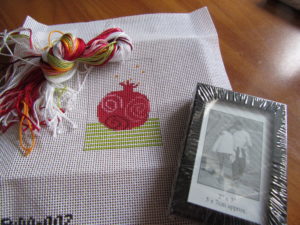
When you decide to do a needlepoint project, what do you think of as the costs? I was reading a post yesterday about epic cross stitch projects that talks about all the costs involved with doing a large project. If you are like me most of them time you pick a canvs because you like it.
Whether you calculate costs when buying or pulling out a project, thinking about these costs is a good idea. Not thinking about this often results in a mismatch in your purchases. The canvas was lovely but buying all the things you need to stitch it will make it just to exoensive. You won’t throw good money after bad, so you don’t stitch it. Now you are left with the canvas. If you thought about those other costs before you took out your credit card, you would have saved money or bought a canvas you would stitch.
Time: How long will it take to stitch? Does the amount of time it will take fit into any deadlines (including finishing) you have? Does the amount of time you need fit your schedule? Is it a gift for someome in your house so you have to “hide” it? Will you have the time in this case?
Has your speed in stitching changed? This is the one that messes me up. I stitch much more slowly these days. But my brain looks at a project and estimates time based on my old stitching speed. As a result I constantly underestimate times. I wish I didn’t.
Thread: How many threads/colors do you need? What threads do you plan to use? How expensive are they?
How easy will it be to get them? If you need to travel to the shop what are the costs associated with this? If you are having threads shipped, what does shipping add to the cost?
Are there threads you need that you have in your stash? Are there threads that you can substitute easily that might cost less? I always shop my stash first. I also often recommend that floss, which is inexpensive, be used for areas where small bits of thread are needed.
I have a mental rule about threads. Except for stash threads, I assume that threads will coast at least as much as the canvas does. In many cases threads cost more than the canvas.
Needles: How many needles do you use on a project? A large project or one that needs different sizes of needles may use many.Do you lose needles? Do you reuse needles?
Even though needles are inexpensive, they can be an expense.
Embellishments: Not all projects have embellishments, but many do. These can add considerably to the cost of the project. Something else that adds to the expense is how big the packages of embellishments are. For example think about beads. If you buy beads at a bead shop, they might be more expensive, but the packages are large. The smaller packages you find in your LNS might cost more, but you don’t end up with huge amounts of leftover beads.
Other embellishments can be very expensive. Charms and accent beads are good examples of this. I have seen charms that cost about $2 and ones that cost $10. Adding some charms can add considerably to the expense.
Accessories: Stretcher bars, scissors, tacks, needle minders, project bags — we put these with our projects regularly. But do you buy new with every project? If so add them into your project cost. If you reuse them, you can divide the cost over several projects.
Do you do this? It’s easy, here’s an example. Lets say you buy a project bag that costs you $10. You are able to use it for 10 projects and the zipper breaks so you need to throw it out. Your cost for the bag was $1 per project. Now think of another bag. It’s $20 and you use it for 50 projects. For that bag, the cost is $.40 per project.
Think about it, which bag ended up being more expensive?
Yes, careful shopping and stewardship can make good use of the money you spend on your hobby, no matter how much you spend. Knowing the costs of your projects can make you a more careful shopper and stitcher.
About Janet M Perry
Janet Perry is the Internet's leading authority on needlepoint. She designs, teaches and writes, getting raves from her fans for her innovative techniques, extensive knowledge and generous teaching style. A leading writer of stitch guides, she blogs here and lives on an island in the northeast corner of the SF Bay with her family

Finishing is the biggest cost hurdle for me. The cost of stitching materials is paid for by the pleasure of stitching, but finishing or framing is wildly expensive and no fun. Yes, it may give me pleasure to see a piece on the wall, but not enough to offset the hundreds of dollars I’d have to spend.
I wish designers, especially those who do geometric patterns that can’t easily be adjusted by adding background, would think of sizing things to fit off-the-shelf frames. (I don’t do the small pieces that fit in the luggage tags, coasters, etc. that you often suggest.)
It seems to me that finishing costs are something pretty important to add to the calculation. These can often be as expensive as the original cost for the painted canvas.
Excellent point. I agree that finishing is a huge hurdle for so many of us. That could be why I have so much stuff that’s stitched but unfunishe!
Keep stitching,
Janet